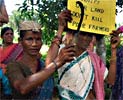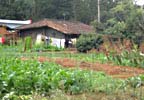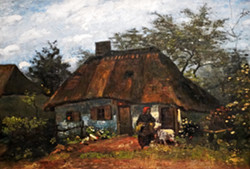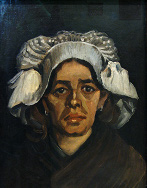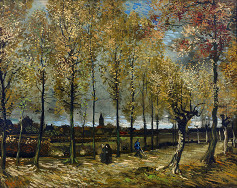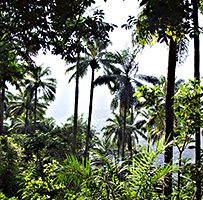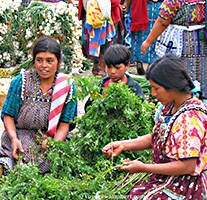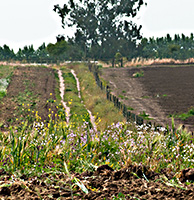Questions to the Author
1. What is a peasant anyway?
2. Is this really the first ‘world history of
peasants’?
3. What gave you the idea to write a peasant
history on the basis of novels and movies?
4. How did you find the books and the movies that you use as source material?
5. How long did you work on your webbook?
6. Everyone can visit your website with your book for free. What is the business model?
8. What do you think about the future of peasants?
11. What is it you want to impress upon our readers?
12. Could you draw a particular conclusion about the history of peasants?
13. Do you have a picture for us?
Article about small scale agriculture
1. What is a peasant anyway?
A peasant is just a farmer with little land, whereas a farmer has much more
land. However, there is more to it than that. Because a peasant and a farmer proceed
completely differently. A peasant tries to apply all the
possibilities the farm and the family offer, and to borrow as little
money as possible, because she or he knows very well that a harvest
can fall short or fail due to bad weather, or because the market
prices drop suddenly.
A farmer,
on the other hand, specializes entirely in a special crop or
livestock, and will borrow as much money as possible to buy still
more land, bigger machines and more buildings in order to produce
and sell still more to survive economically. A peasant family produces what it needs and the surplus is to
sell; it is with the heart focused on the land, which it owns
already for generations. The farmer focuses entirely on ‘the market’. The peasant tries to preserve independence however possible, for
example by selling to citizens directly from the farm or at a
farmers market. A farmer follows the government policy of scaling up, and
delivers the farm’s products to big corporations.
A peasant
and a farmer
have different outlooks on life; but still there isn’t a clear
dividing line between them, because in between the peasant and the farmer is the medium-sized farmer, combining characteristics
of both of them.
By the way, ‘peasants’ include agricultural
workers with or without a small plot of land of their own, small
fishermen, shepherds, nomads with a herd, and indigenous people who
work on the land. All these different types of peasants are
addressed in my webbook.
2. Is this really the first
‘world history of peasants’?
Well, there are scientific books describing certain aspects of
peasant life, think for example of Peasant Unrest in
Latin America from professor Gerrit Huizer.
Or anthropological studies about a particular tribe living from
agriculture. But as far as I know, there doesn’t exist an
easy-to-read book bringing together aspects of many peoples in
different times, giving the reader a good
impression what peasant life is really like. And that is remarkable,
because about 40 percent of the world population today can be
defined as peasantry.
3. What gave you the idea to write a peasant history on the basis of novels and movies?
In fact, I am an agricultural journalist, and I have travelled extensively in India, visiting remote villages. Once, I asked my good Indian friend Manoj Pande whether there were good Indian novels and feature films about peasant life. Together in New Delhi we went to buy the fine novel Godaan, The Gift of the Cow from the popular Indian writer Munshi Premchand, and after that, a DVD of the poignant film Two Acres of Land from director Bimal Roy. Then I realised just how effectively fiction could give clear insight into the nature of peasant life.
Later on, I read Memory of Fire from the Uruguayan journalist and writer Eduardo Galeano. In this impressive trilogy he describes the history of Latin America by means of many short stories, arranged chronologically. That gave me the idea to write a history of peasants in a similar manner. Galeano, however, started from anecdotes he found in all sort of scientific reports, and I from historical novels and movies, because I am a long-time fan of them.
It also seemed to me that it was high time for such a book to appear, bringing together multiple aspects of peasant life, giving the reader a good comprehensive picture of its joys and sorrows, and of the important role that peasants have played in history. Think of the peasant revolutions in Mexico, China, Algeria and Vietnam.
4. How did you find the books and the movies that you use as source material?
When I started my big project, I remembered beautiful books I had read earlier, like The Grapes of Wrath from John Steinbeck, or movies I had seen already, like the masterpiece Novecento from director Bernardo Bertolucci. Of course I asked left and right, went to second-hand and antiquarian bookshops, and searched the catalogue of the public library in Amsterdam, the city where I live. But what has helped me the most are the reference works, 1001 Books You Must Read Before You Die from Peter Boxall and 1001 Movies You Must See Before You Die from Steven Jay Schneider. These two books have put me on the trail of quite a few well-suited writers and directors.
5. How long did you work on your webbook?
Around five years. But – smiling – it hasn’t been a punishment. I have read the most moving novels and seen the most wonderful films. I really hope that some readers of my webbook will be inspired to look for a few books in the library or by internet at a second-hand bookshop. A whole world opens up to you.
6. Everyone can visit your website with your book for free. What is the business model?
(Laughing) Well, business model … I am from the days when journalists and writers didn’t know that expression. I have worked with a lot of pleasure on this book, and I hope some readers will gain a deeper understanding of the beauties and torments of peasant life, and of the importance and the possibilities of small-scale agriculture. If that happens, I am enough rewarded.
7. Are you a peasant yourself, or do you come from a peasant family? And do you live in the countryside?
I come from a middle-class family, and I have lived for many years in the city of Amsterdam. But as a toddler I lived in a village, then in a town and later on, from age ten, in the peasant village of Nuenen, where Vincent van Gogh had also lived and about which he drew and painted so well. Our house was on the outskirts of the village, and the farmland behind it was part of a landscape protection area, whereby it was not subdivided. You found there friendly small plots of land, with dirt roads, and here and there an old piece of marshland, where you could hear the nightingale sing in the evening. There were some meadows where the cows were grazing or a workhorse, and a few fields with wheat, barley, rye, oats or root vegetables. The farms had lovely kitchen gardens. But also in our village the scaling-up struck, with all the obvious dramas.
Our parents didn’t have much time for us. When I was between the ages of two and ten, my mother twice had a peasant girl as household help. Practically speaking, I was brought up by them. From them I got a peasant heart, I could say.
8. What do you think about the future of peasants?
I am not an agricultural expert, but I think that everyone can see how difficult the peasant life is all over the world: governments focus on large-scale agriculture, international trade agreements reduce the revenues from agricultural products, and multinationals constantly raise the prices of agricultural chemicals.
As an agricultural journalist I have often been in India, and there you see that, because of these pressures, many peasants don’t see an alternative other than to take their own life. Some experts shrug their shoulders, because they think that small-scale agriculture is obsolete. Big machines will do the work on mega-farms, and peasants might better look for work in the city. But that’s not how to think about it. About 40 percent of the world population is peasant, and the cities never can absorb them all. Small-scale agriculture is essential in the fight against global warming, because it uses much less fossil fuel than heavily mechanised large-scale agriculture. Also, healthy food, a nice landscape and a vital countryside with a lot of employment are not possible without a thriving peasantry. The only thing the government has to do is to ensure fair prices for agricultural products grown in environmentally sound ways. And to provide for as good education and healthcare facilities in rural areas as in the cities. The world will blossom by it!
9. I thought there are fewer and fewer peasants, because more and more people are going to live in the cities?
It is true that here is a worldwide migration from the land to the cities. But still about 40 percent of the world population is peasant. And in absolute numbers, there are nowadays even more peasants than ever in the world’s history. Therefore, small-scale agriculture is absolutely not a marginal phenomenon.
10. What is your dream?
Well, my dream … In fact, that small-scale agriculture, which I experienced in my youth, will come back. Yes, I understand that I can’t turn back the clock, but the world is crying out for small-scale agriculture: healthy food, drastic reduction of carbon dioxide emissions, slowing rural-urban migration, more employment and less poverty in the Third World. All of that points in the direction of small-scale family farming, peasant farming. And the peasantry is ready for it; I have seen it in India in many villages, and also in the West there are so many young people developing wonderful farms. Now the government – for heaven’s sake, what is it waiting for?
At the end of 2018 the United Nations adopted a Declaration on the Rights of Peasants. It did me so much good. For centuries the word peasant was, in the mouth of a city dweller, nothing more than a term of abuse. Now the word peasant is something to be proud of. The injustices of centuries have to be made right, the exploitation brought to a halt. It’s high time, because the quality of our food and environment are at stake, and the living conditions of a few billions of fellow world citizens. All of that, we cannot ignore.
11. What is it you want to impress upon our readers?
Dear reader, please sit down quietly. Take your time to immerse yourself through my webbook in exploring the lives of peasants, how difficult that was and how beautiful, how difficult and beautiful it still is, and how many opportunities it offers, at this very moment, to make the life of all of us healthier and better. It is within our reach!
12. Could you draw a particular conclusion about the history of peasants?
The peasant life is so varied and so all-encompassing, that any summary on my part would diminish it. Beyond that, every reader will have her or his own thoughts, assumptions, and feelings when reading a story. I would like to leave those intact.
13. Do you have a picture for us?
(Smiling) Of myself? No, I don’t have one on hand. But look in the webbook at the overview pages. There you will find many pictures of peasants from all over the world. Just pick a few of them.
About the author
Jan Paul Smit (1951) is a Dutch journalist and writer. He travelled extensively through India and made the television documentary Mother Earth – a new future for small farmers (2007), about the revival of traditional farming.
Article about small scale agriculture
For an excellent article about the importance of the restoration of small-scale agriculture, particularly for the poor in the Global South, and for a detailed list of measures the government has to take for it, see the article Growing back stronger – Choosing resilient food systems in the wake of Covid-19 from agricultural professor Jan Douwe van der Ploeg.
Go to:
= the Homepage of 'A Peasant History',
= the Table of contents.
